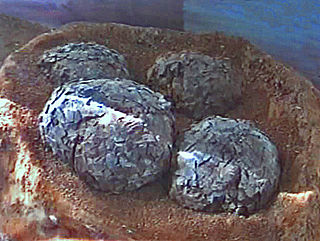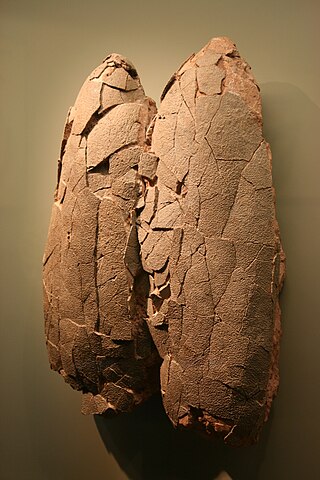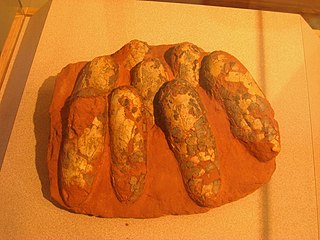
Elongatoolithus is an oogenus of dinosaur eggs found in the Late Cretaceous formations of China and Mongolia. Like other elongatoolithids, they were laid by small theropods, and were cared for and incubated by their parents until hatching. They are often found in nests arranged in multiple layers of concentric rings. As its name suggests, Elongatoolithus was a highly elongated form of egg. It is historically significant for being among the first fossil eggs given a parataxonomic name.

Dendroolithus is an oogenus of Dendroolithid dinosaur egg found in the late Cenomanian Chichengshan Formation, in the Gong-An-Zhai and Santonian Majiacun Formations of China and the Maastrichtian Nemegt and Campanian Barun Goyot Formation of Mongolia. They can be up to 162 mm long and 130 mm wide. These eggs may have been laid by a Therizinosaur, Sauropod, or Ornithopod. The oospecies "D." shangtangensis was originally classified as Dendroolithus, however, it has since been moved to its own distinct oogenus, Similifaveoloolithus. This oogenus is related with embryos of the theropod Torvosaurus
Stromatoolithus is an oogenus of dinosaur egg. The oogenus contains one oospecies, S. pinglingensis.

Youngoolithus is an oogenus of dinosaur egg. It is the sole member of the oofamily Youngoolithidae, and consists of a single oospecies: Youngoolithus xiaguanensis. It consists of a single fossil nest of 16 eggs with an associated dinosaur footprint that was first discovered in 1975 in the Majiacun Formation near Houzhuang Village, Henan Province, in the Cretaceous Xiaguan Basin. The eggs are smooth, olive-shaped, and arranged in five rows. It was originally described as being a Faveoloolithid egg, however the nest is arranged quite differently than other members of that family, so it has been moved to its own oofamily, Youngoolithidae.

Faveoolithus is an oogenus of dinosaur egg. The oogenus contains two oospecies, F. ningxiaensis and F. zhangi.

Megaloolithus is an oogenus of dinosaur egg. Some eggs belonging to this oogenus may have been laid by the titanosaur Hypselosaurus. They are known for having thick eggshells, at least 1.5 millimetres (0.059 in) thick, and the nearly spherical shape of the eggs. They are primarily found in India and Europe, but some specimens have been found in South America.

Ovaloolithus is an oogenus of dinosaur egg. Eggs of the genus have been found in China, Mongolia and Utah.

Spheroolithus is an oogenus of dinosaur egg.

Prismatoolithus is an oogenus of dinosaur egg from the Cretaceous (Hauterivian-Maastrichtian) and possibly also the earliest Paleocene. They likely belonged to troodontids
Protoceratopsidovum is an oogenus of dinosaur egg from Mongolia. Despite its name, it does not represent the eggs of a protoceratopsid, but rather the eggs of maniraptoran theropods.
Pseudogeckoolithus is an oogenus of dinosaur egg. It is known from several fragments of eggshells. The outer surface of these are covered with little knobs and nodes. Some of the pores in the eggshell open through these nodes, similar to modern geckos, but unique among the dinosauroid-prismatic group of eggs. However, the microstructure of Pseudogeckoolithus shows that it is not actually of the geckoid type. It is possible that these eggs represent a new basic group of fossil eggs.
Ellipsoolithus is an oogenus of dinosaur egg. It contains only a single oospecies, E. khedaensis. The species was found in the Upper Sandy Carbonate Member of the Lameta Formation of India. These eggs were probably laid by a theropod dinosaur.

Macroelongatoolithus is an oogenus of large theropod dinosaur eggs, representing the eggs of giant caenagnathid oviraptorosaurs. They are known from Asia and from North America. Historically, several oospecies have been assigned to Macroelongatoolithus, however they are all now considered to be a single oospecies: M. carlylensis.

Macroolithus is an oogenus of dinosaur egg belonging to the oofamily Elongatoolithidae. The type oospecies, M. rugustus, was originally described under the now-defunct oogenus name Oolithes. Three other oospecies are known: M. yaotunensis, M. mutabilis, and M. lashuyuanensis. They are relatively large, elongated eggs with a two-layered eggshell. Their nests consist of large, concentric rings of paired eggs. There is evidence of blue-green pigmentation in its shell, which may have helped camouflage the nests.
Trachoolithus is an oogenus of dinosaur egg. It only contains the oospecies T. faticanus, found in the Lameta Formation of India and the Dushihin Formation of Mongolia.
Phaceloolithus is an oogenus of dinosaur egg found in the Fenshui'ao Formation of the Dongting Basin of the Hunan Province of China. The eggs have a subspherical shape, measuring up to 168 mm on the long axis, and having a very thin shell.
Laevisoolithus is an oogenus of fossil egg. Its sole oospecies, L. sochavai, is native to the Nemegt Formation in Mongolia. Laevisoolithus is characterized by its thin, smooth eggshells. These eggs were probably laid by a bird or a small theropod.
Subtiliolithus is an oogenus of fossil egg from the Nemegt Formation of Mongolia and the Ohyamashimo Formation of Japan. The eggs are notable for a very thin eggshell. It contains three oospecies: S. hyogoensis, S. kachchhensis and S. microtuberculatus. They were originally classified as a distinct oofamily, Subtiliolithidae, but numerous similarities to Laevisoolithus have led to their reclassification as Laevisoolithid eggs. A complete skeleton of Nanantius valifanovi was found associated with Subtiliolithus eggshells, indicating that the oogenus represents eggs of enantiornithine birds.

Elongatoolithidae is an oofamily of fossil eggs, representing the eggs of oviraptorosaurs. They are known for their highly elongated shape. Elongatoolithids have been found in Europe, Asia, and both North and South America.

Gobioolithus is an oogenus of fossil bird egg native to Mongolia. They are small, smooth-shelled, and elongated eggs that were first discovered in the 1960s and early 70s during a series of fossil-hunting expeditions in the Gobi desert. Two oospecies have been described: Gobioolithus minor and G. major. The eggs were probably laid in colonial nesting sites on the banks of rivers and lakes.











